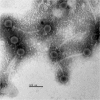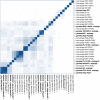Characterization of prophages of Lactococcus garvieae
- PMID: 28500301
- PMCID: PMC5431838
- DOI: 10.1038/s41598-017-02038-y
Characterization of prophages of Lactococcus garvieae
Abstract
This report describes the morphological characterization and genome analysis of an induced prophage (PLg-TB25) from a dairy strain of Lactococcus garvieae. The phage belongs to the Siphoviridae family and its morphology is typical of other lactococcal phages. A general analysis of its genome did not reveal similarities with other lactococcal phage genomes, confirming its novelty. However, similarities were found between genes of its morphogenesis cluster and genes of Gram-positive bacteria, suggesting that this phage genome resulted from recombination events that took place in a heterogeneous microbial environment. An in silico search for other prophages in 16 L. garvieae genomes available in public databases, uncovered eight seemingly complete prophages in strains isolated from dairy and fish niches. Genome analyses of these prophages revealed three novel L. garvieae phages. The remaining prophages had homology to phages of Lactococcus lactis (P335 group) suggesting a close relationship between these lactococcal species. The similarity in GC content of L. garvieae prophages to the genomes of L. lactis phages further supports the hypothesis that these phages likely originated from the same ancestor.
Conflict of interest statement
The authors declare that they have no competing interests.
Figures





Similar articles
-
Properties and genomic analysis of Lactococcus garvieae lysogenic bacteriophage PLgT-1, a new member of Siphoviridae, with homology to Lactococcus lactis phages.Virus Res. 2016 Aug 15;222:13-23. doi: 10.1016/j.virusres.2016.05.021. Epub 2016 May 24. Virus Res. 2016. PMID: 27234995
-
Comparative genomic analysis of three lytic Lactococcus garvieae phages, novel phages with genome architecture linking the 936 phage species of Lactococcus lactis.Mar Genomics. 2019 Dec;48:100696. doi: 10.1016/j.margen.2019.100696. Epub 2019 Jul 10. Mar Genomics. 2019. PMID: 31301990
-
A virulent phage infecting Lactococcus garvieae, with homology to Lactococcus lactis phages.Appl Environ Microbiol. 2015 Dec;81(24):8358-65. doi: 10.1128/AEM.02603-15. Epub 2015 Sep 25. Appl Environ Microbiol. 2015. PMID: 26407890 Free PMC article.
-
Comparative genomics of phages and prophages in lactic acid bacteria.Antonie Van Leeuwenhoek. 2002 Aug;82(1-4):73-91. Antonie Van Leeuwenhoek. 2002. PMID: 12369206 Review.
-
Phages of dairy bacteria.Annu Rev Microbiol. 2001;55:283-303. doi: 10.1146/annurev.micro.55.1.283. Annu Rev Microbiol. 2001. PMID: 11544357 Review.
Cited by
-
Evidence of pediatric sepsis caused by a drug resistant Lactococcus garvieae contaminated platelet concentrate.Emerg Microbes Infect. 2022 Dec;11(1):1325-1334. doi: 10.1080/22221751.2022.2071174. Emerg Microbes Infect. 2022. PMID: 35475418 Free PMC article.
-
Comparative genomics and evolutionary analysis of Lactococcus garvieae isolated from human endocarditis.Microb Genom. 2022 Feb;8(2):000771. doi: 10.1099/mgen.0.000771. Microb Genom. 2022. PMID: 35196218 Free PMC article.
-
Towards the diversification of lactococcal starter and non-starter species in mesophilic dairy culture systems.Microb Biotechnol. 2023 Sep;16(9):1745-1754. doi: 10.1111/1751-7915.14320. Epub 2023 Jul 15. Microb Biotechnol. 2023. PMID: 37606352 Free PMC article. Review.
-
A Plasmid-Encoded Surface Polysaccharide Partly Blocks Ceduovirus Infection in Lactococci.Int J Mol Sci. 2025 Mar 11;26(6):2508. doi: 10.3390/ijms26062508. Int J Mol Sci. 2025. PMID: 40141150 Free PMC article.
-
In Silico Evidence of the Multifunctional Features of Lactiplantibacillus pentosus LPG1, a Natural Fermenting Agent Isolated from Table Olive Biofilms.Foods. 2023 Feb 22;12(5):938. doi: 10.3390/foods12050938. Foods. 2023. PMID: 36900455 Free PMC article.
References
-
- Davies, E. V., Winstanley, C., Fothergill, J. L. & James, C. E. The role of temperate bacteriophages in bacterial infection. FEMS Microbiol. Lett. 363(5), fnw015, doi:10.1093/femsle/fnw015 (2016). - PubMed
Publication types
MeSH terms
LinkOut - more resources
Full Text Sources
Other Literature Sources
Molecular Biology Databases
Miscellaneous

